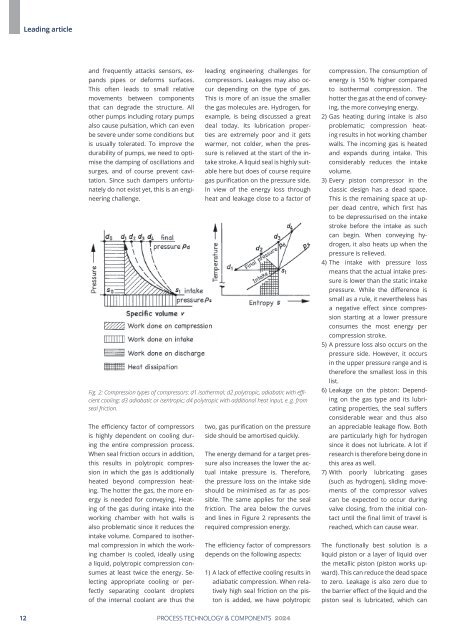PuK - Process Technology & Components 2024
A technical trade magazine with a history of more than 60 years.
A technical trade magazine with a history of more than 60 years.
You also want an ePaper? Increase the reach of your titles
YUMPU automatically turns print PDFs into web optimized ePapers that Google loves.
Leading article<br />
and frequently attacks sensors, expands<br />
pipes or deforms surfaces.<br />
This often leads to small relative<br />
movements between components<br />
that can degrade the structure. All<br />
other pumps including rotary pumps<br />
also cause pulsation, which can even<br />
be severe under some conditions but<br />
is usually tolerated. To improve the<br />
durability of pumps, we need to optimise<br />
the damping of oscillations and<br />
surges, and of course prevent cavitation.<br />
Since such dampers unfortunately<br />
do not exist yet, this is an engineering<br />
challenge.<br />
leading engineering challenges for<br />
compressors. Leakages may also occur<br />
depending on the type of gas.<br />
This is more of an issue the smaller<br />
the gas molecules are. Hydrogen, for<br />
example, is being discussed a great<br />
deal today. Its lubrication properties<br />
are extremely poor and it gets<br />
warmer, not colder, when the pressure<br />
is relieved at the start of the intake<br />
stroke. A liquid seal is highly suitable<br />
here but does of course require<br />
gas purification on the pressure side.<br />
In view of the energy loss through<br />
heat and leakage close to a factor of<br />
Fig. 2: Compression types of compressors: d1 isothermal; d2 polytropic, adiabatic with efficient<br />
cooling; d3 adiabatic or isentropic; d4 polytropic with additional heat input, e. g. from<br />
seal friction.<br />
The efficiency factor of compressors<br />
is highly dependent on cooling during<br />
the entire compression process.<br />
When seal friction occurs in addition,<br />
this results in polytropic compression<br />
in which the gas is additionally<br />
heated beyond compression heating.<br />
The hotter the gas, the more energy<br />
is needed for conveying. Heating<br />
of the gas during intake into the<br />
working chamber with hot walls is<br />
also problematic since it reduces the<br />
intake volume. Compared to isothermal<br />
compression in which the working<br />
chamber is cooled, ideally using<br />
a liquid, polytropic compression consumes<br />
at least twice the energy. Selecting<br />
appropriate cooling or perfectly<br />
separating coolant droplets<br />
of the internal coolant are thus the<br />
two, gas purification on the pressure<br />
side should be amortised quickly.<br />
The energy demand for a target pressure<br />
also increases the lower the actual<br />
intake pressure is. Therefore,<br />
the pressure loss on the intake side<br />
should be minimised as far as possible.<br />
The same applies for the seal<br />
friction. The area below the curves<br />
and lines in Figure 2 represents the<br />
required compression energy.<br />
The efficiency factor of compressors<br />
depends on the following aspects:<br />
1) A lack of effective cooling results in<br />
adiabatic compression. When relatively<br />
high seal friction on the piston<br />
is added, we have polytropic<br />
compression. The consumption of<br />
energy is 150 % higher compared<br />
to isothermal compression. The<br />
hotter the gas at the end of conveying,<br />
the more conveying energy.<br />
2) Gas heating during intake is also<br />
problematic; compression heating<br />
results in hot working chamber<br />
walls. The incoming gas is heated<br />
and expands during intake. This<br />
considerably reduces the intake<br />
volume.<br />
3) Every piston compressor in the<br />
classic design has a dead space.<br />
This is the remaining space at upper<br />
dead centre, which first has<br />
to be depressurised on the intake<br />
stroke before the intake as such<br />
can begin. When conveying hydrogen,<br />
it also heats up when the<br />
pressure is relieved.<br />
4) The intake with pressure loss<br />
means that the actual intake pressure<br />
is lower than the static intake<br />
pressure. While the difference is<br />
small as a rule, it nevertheless has<br />
a negative effect since compression<br />
starting at a lower pressure<br />
consumes the most energy per<br />
compression stroke.<br />
5) A pressure loss also occurs on the<br />
pressure side. However, it occurs<br />
in the upper pressure range and is<br />
therefore the smallest loss in this<br />
list.<br />
6) Leakage on the piston: Depending<br />
on the gas type and its lubricating<br />
properties, the seal suffers<br />
considerable wear and thus also<br />
an appreciable leakage flow. Both<br />
are particularly high for hydrogen<br />
since it does not lubricate. A lot if<br />
research is therefore being done in<br />
this area as well.<br />
7) With poorly lubricating gases<br />
(such as hydrogen), sliding movements<br />
of the compressor valves<br />
can be expected to occur during<br />
valve closing, from the initial contact<br />
until the final limit of travel is<br />
reached, which can cause wear.<br />
The functionally best solution is a<br />
liquid piston or a layer of liquid over<br />
the metallic piston (piston works upward).<br />
This can reduce the dead space<br />
to zero. Leakage is also zero due to<br />
the barrier effect of the liquid and the<br />
piston seal is lubricated, which can<br />
12<br />
PROCESS TECHNOLOGY & COMPONENTS <strong>2024</strong>

















